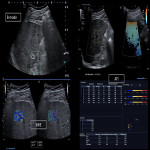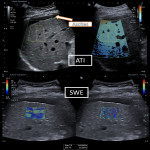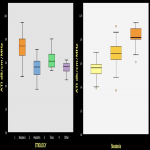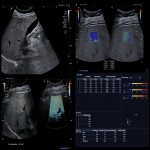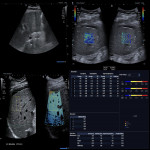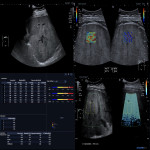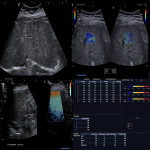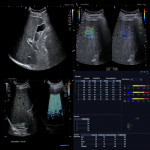Purpose
The prevalence of steatosis in patients with chronic liver disease is growing worldwide [2].
Hepatic fibrosis staging has been used as a prognostic factor by clinicians to measure clinical outcomes and as an index to establish therapeutic plans in patients with chronic liver disease (CLD) [1;2].
Multiparametric approach using the new ultrasound technique as attenuation imaging (ATI) and dispersion imaging for quantitative evaluation of steatosis and viscosity in cases of diffuse chronic diseases, helps to detect the changes without using the invasive methods. [3;4;5].
The...
Methods and materials
Total 154 patients were enrolled in a prospective study between April 2019 and December 2020, where 98 patients with the confirmed diffuse liver disease, 17 healthy patients (63 women and 52 men, median age 52.0) and additionally 56 patients with proven SARS-CoV-19.
Patients with the severe liver parenchymal changes due to rare disease as Budd-Chiari and Wilson disease were excluded.
For fibrosis, steatosis detection and viscosity quantification the multiparametric measurements were performed by three radiologists, experienced in abdominal ultrasound: B-mode imaging, 2D shear-wave elastography measurements,...
Results
There was a statistically significant difference among etiology groups and ATI (p=0.0001) with predominantly high attenuation intensity range dB/cm/MHz >0.65-0.8 in steatohepatosis (strong correlation r=0.71; p=0.0001).
Relatively high attenuation intensity range was detected in toxic hepatitis group up to 0.55-0.65 dB/cm/MHz with steatosis qualitative assessment on B mode image (normal or hyperechogenic liver structure) (rs=0.5; p=0.0001) (Figure 3, Figure 4, Figure 5). [Fig 3] [Fig 4] [Fig 5]
Alterations in liver tissue viscosity to the stage of fibrosis were revealed with positive correlation (rp=0.40; p=0.005)...
Conclusion
Multiparametric ultrasound evaluation of liver can be helpful in chronic liver disease as well as post Covid-19 patients as added value with reliable quantitative measurements in steatohepatosis, viscosity and fibrosis.
Personal information and conflict of interest
Y. Solskaya:
Nothing to disclose
M. Tirane:
Nothing to disclose
P. Prieditis:
Nothing to disclose
A. Staka:
Nothing to disclose
A. Upena:
Nothing to disclose
L. Saule:
Nothing to disclose
M. Radzina:
Nothing to disclose
References
McCuskey, R., Boyer, TD., Manns, MP. et al. Hepatology: a Textbook of liver disease. 6th ed. Philadelphia, PA, USA: Elsevier Saunders, 2012; p. 3-19
Piscaglia, F., Nolsoe, C., Dietrich, CF. et al. EFSUMB Guidelines and Recommendations on the Clinical Use of Liver Ultrasound Elastography, update on 2017, Ultraschall Med. 2017;29:28-44
Barr, RG., Ferraioli, G., Palmeri, M. et al. Letal Elastography Assessment of Liver Fibrosis: Society of Radiologists in Ultrasound Consensus Conference Statement. Radiology 2015; 276: 845 – 861
Sidhu, P., Brabrand, K., Cantisani, V. et...

